How can you develop two parts of the game for six months and not go crazy
In the era of news that almost every day there are new viruses or how hackers stole a huge amount of money, it seemed to us that the mobile gaming market lacked a cool game about hackers.
My name is Yuri, I am one of the creators and developer of two series of games. I want to share the experience of their creation and a little experience of promotion.
This article does not touch upon the implementation details (there is not a single line of code here), but only outlines a bit of routine, but at the same time unusual process of indie game development.

The idea of the project
How did it all start? Once, my friend-designer and I were discussing mobile games. Thought to create a game and swim in gold We both liked. How did we come up with the idea?
In May 2017, we met in the evenings and were engaged in generating different ideas.
We chose the standard of the games we wanted to be:
- Plague Inc
- Simulator of Russia 2
Wrote a list of items that must be in our game:
- Bleeding character
- Nonlinear passage
- Hardcore
- The presence of humor in the game
- Competitive component (earning points).
For these components is perfectly suited to the genre simulator. The same genre was with our standards.
And what crazy ideas didn’t occur to us. Here are some examples:
- plant simulator
- night club owner simulator
- airplane simulator
But all ideas clearly lacked some kind of spark.
At that time, the network had news about another hacker or virus. The idea of hackers and the development of a computer virus came to us almost immediately. We began to develop it, going through all the points made by us:
- Virus leveling
- Nonlinear virus pumping and non-linear development of antivirus
- Hardcore
- “Live” chat from residents who would write about the current state of the virus
- The competitive part was the rate of infection of the entire city.
Creating the first part
The first part was decided to be implemented in Swift.
We refused Unity because of its bulk and complexity (oh, if we knew what would happen next).
The designer drew the first layout of the city, it was made in a minimalist style. Also, the concept of infection was invented. Computers and smart appliances will be infected in homes.
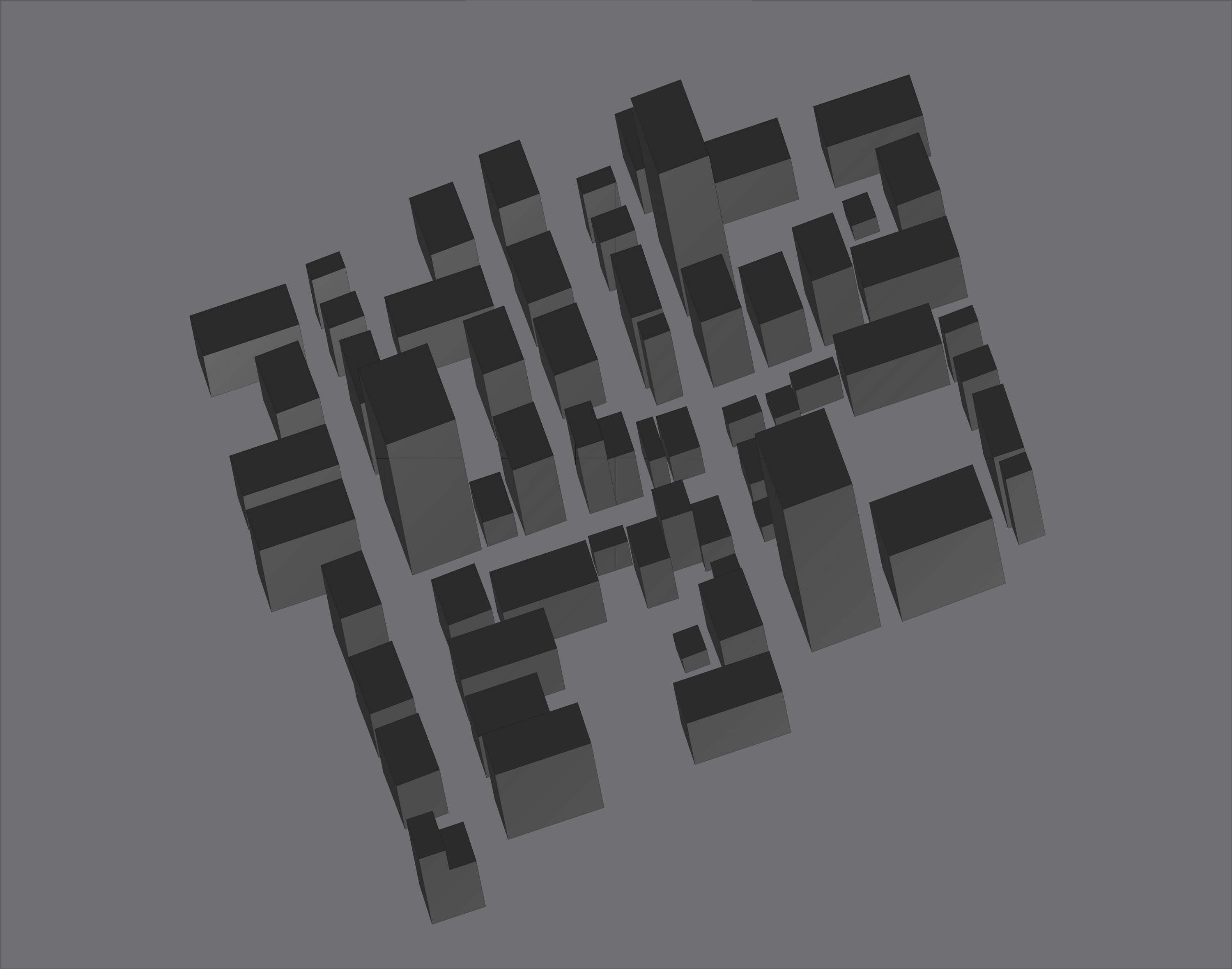
There will also be people with smartphones. The roofs of the houses will be filled with color, showing the progress of infection of the house, and the blue circles will show infected smartphones. The process of infecting devices must be automatic.
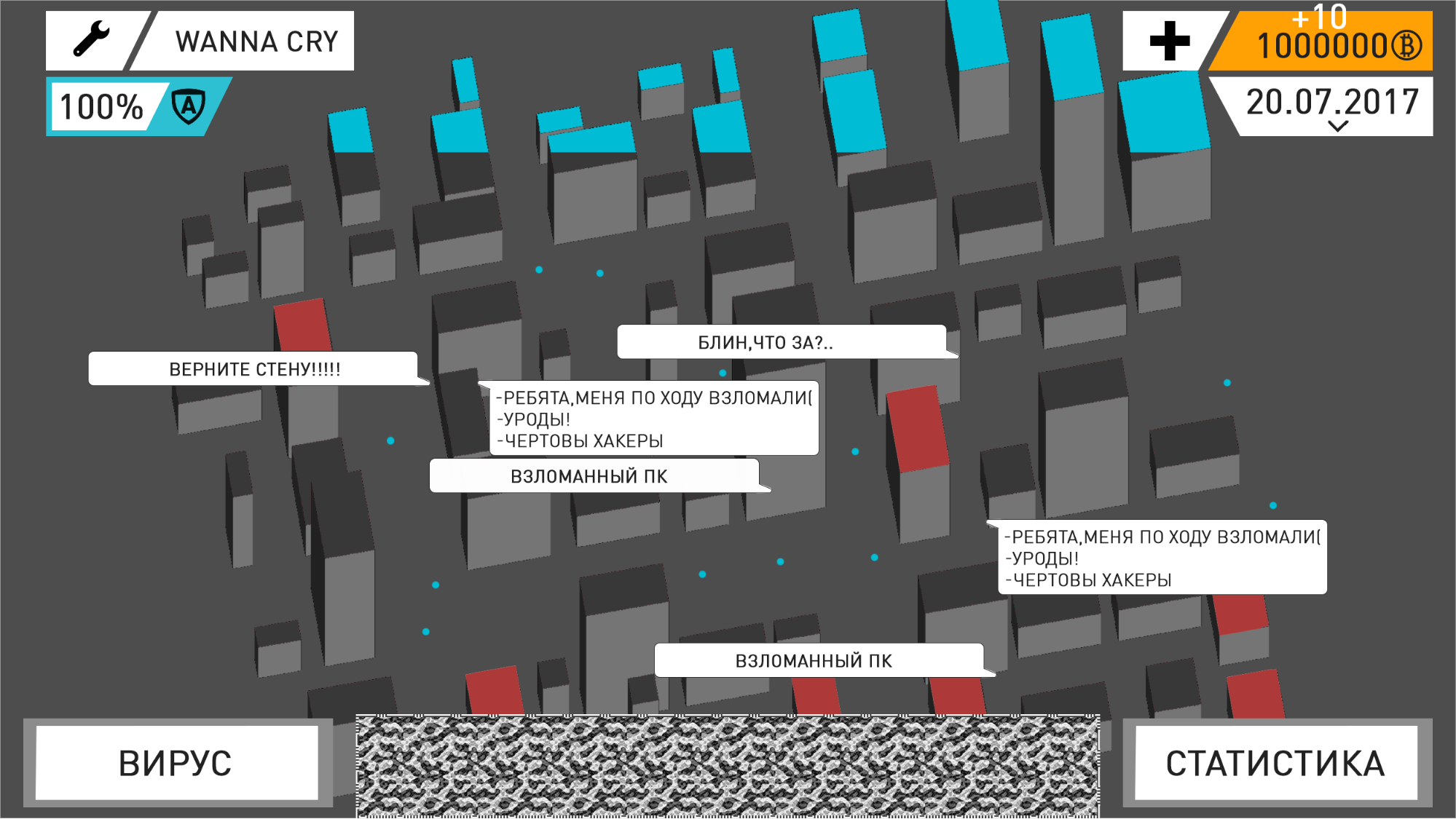
From some point an antivirus begins to be developed, and the time of its development depends on the parameters of the virus and on some other random parameters.
We also created a city chat. At a random moment, a message was displayed above the house with text that conveys the emotions and state of the devices in humans.
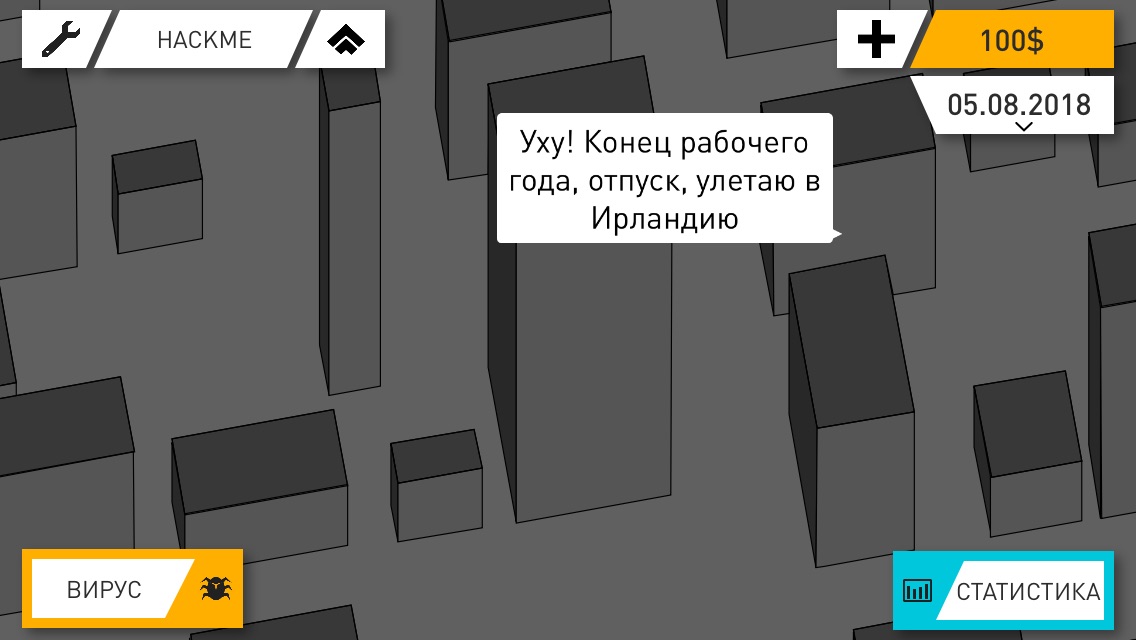
The main task in the game is to infect all devices as quickly as possible. To calculate the statistics used by Apple's GameCenter.
Somewhere after a month of development was the first working prototype. But we lacked some kind of interactive. Watching for a virus that infects a city and makes money becomes boring.
It was decided to add “problem” houses. That is, after the start of the development of an antivirus at a random point in time, a house appears, for which manual intervention is needed. We called this process “Perform DDoS Attack”.

It was a separate mini-game, with the winnings of which the house is completely infected. In case of loss, the antivirus is enhanced. Manual infection is very diluted game and brought a lot of interactive.
Somewhere else, about two months, we spent on finalizing the game balance, adding new levels of complexity and graphical improvements.
This is how the virus design screen began to look.
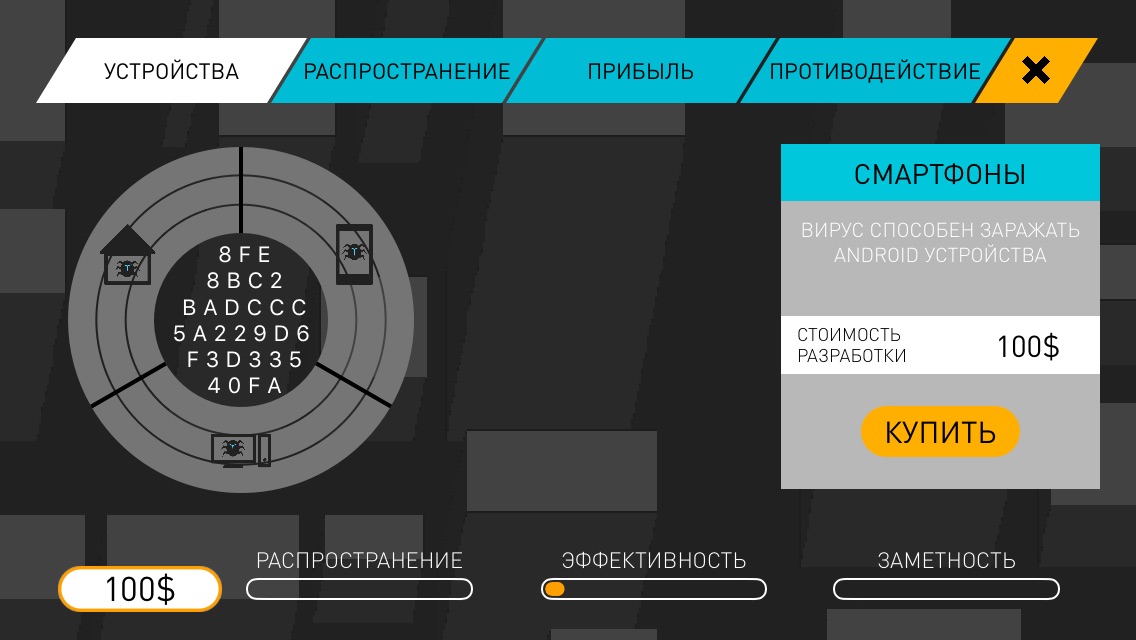
So the main screen of the game
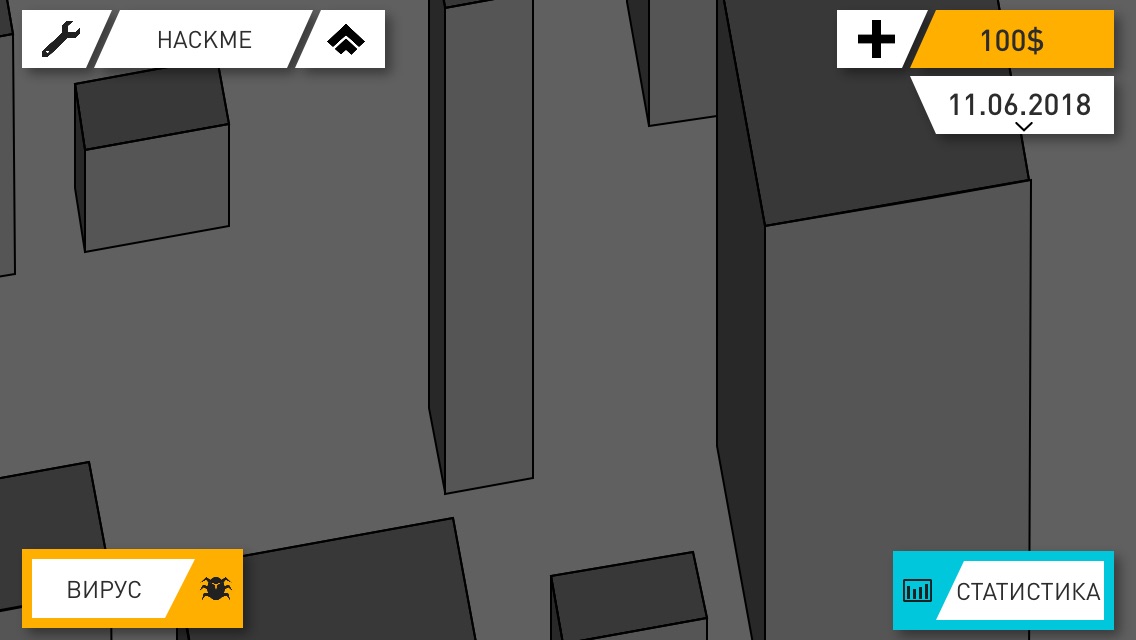
In the release of the game, we had one card and 3 different difficulty levels.
Levels can be pereprohodit, improving their time.
The game is made like free to play. That is, the game has advertising (which could be turned off for money) and in-game purchases.
The result: the game was made in 3 months (July - October).
In late September, our game was reviewed in the AppStore.
Promotion and results of the first part
A month before the release, VK was created in the AppStore, a page on the gamedev forum, a facebook page (for an English-speaking audience). As soon as we had the first screenshots, we started writing indie games to groups. The first feedback and the first users of our group were received.
After the release, it was decided to spend 21,000 rubles on advertising.
About 13,000 rubles was spent on native advertising in the VC tape. The rest of the money was spent on posts in groups related to apple.
A total of advertising lasted for 10 days. It was received about 15 thousand installations. All these 10 days we were in the top free simulator.
Better place we reached in the TOP - 26.
If you say, what advertising is better, then in my experience - advertisements in the tape. These ads can be created using the MyTarget service.
Over 1000 impressions, the average price was 12 rubles, while the CTR always reached more than 1.2%.
If the campaign had a game audience (VK game groups), then the CTR could reach 2%. On average, 1 transfer of a person cost us 1 ruble.
If we talk about posts in the groups, many large groups (more than 500 thousand people) gave us about 500-1000 transitions. The cost of the post ranged from 2 to 3 thousand rubles.
As soon as the advertising was over, the installations fell and we left the TOP. Then another couple of weeks was 100-150 installations per day. Currently, the number of installations per day is about 20.
We received a big feedback, rated 4.2 stars on the AppStore. But most importantly, we saw that the game has potential. People liked the concept of automatic infection and manual intervention. We began to think what to do next.
What's next?
So, we saw that people like the game. There were ideas for further development of the game:
- Adding other levels
- Adding other types of manual infection
- Adding “bosses”
But the graphics that we had at the moment did not really like the designer. He wanted cooler. I attach the layout of his new vision.

But the problem was that I did not know how to implement such a schedule.
Here it is necessary to make a little explanation. Rendering of buildings and people was done programmatically using CALayer. That is, we had JSON with the coordinates of the houses (their roofs, walls), which was parsed and outlined in CALayer. It was a terribly inconvenient, but the only way working at that time.
I decided to look for ways to implement such graphics. And since the designer was just drawing screen layouts, and I was working on screen layout and drawing a level map, I wanted to shift some of this responsibility to him.
At first I was looking for ways in Xcode. Found a Game Scene (which is similar to Unity Scene). But not really figured it out. The designer insisted on Unity. So we could still make the game under Android.
We decided to try using it.
Creating the second part
I must say, I thought that it would take a lot of time to study the Unity platform and the c # language (before that, I had done several labs at the university). But it turned out, it is not. Unity was simple, straightforward, and had a large active audience.
And the most important thing in Unity was that the designer could design the game, draw the level map (in fact, in our case it was the transfer of pictures from the layout to the stage), and I could develop the software functionality that needed to be rewritten from the very beginning. Development began in November 2017.
Have we got a question? Will it be a major update of the first part or is it already a new game? After the first results, we realized that in comparison with the previous game, the new one will have enormous differences in the schedule. We decided that this will be the second part.
After 2 weeks we made the first working level prototype.
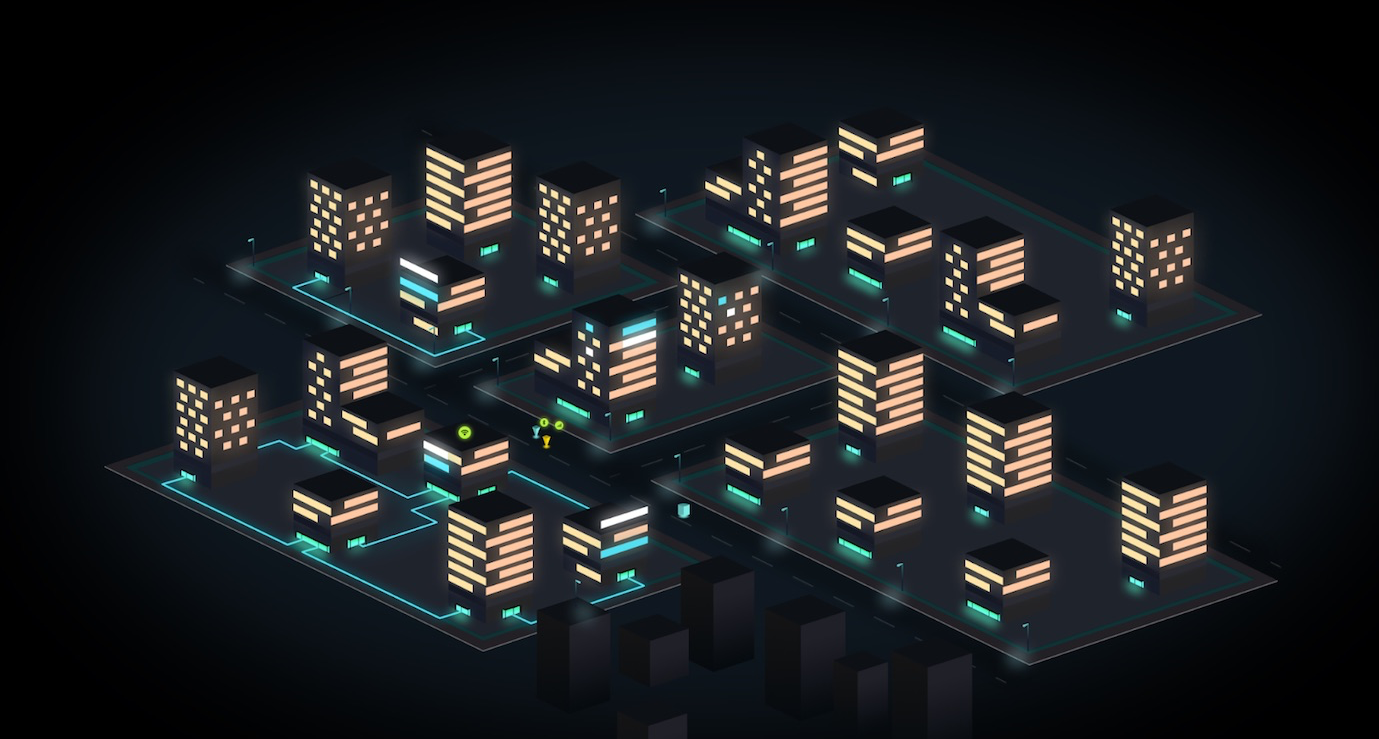
The result was on the face.
Somewhere else after 2 weeks, the virus development screen was made and the infection process implemented.

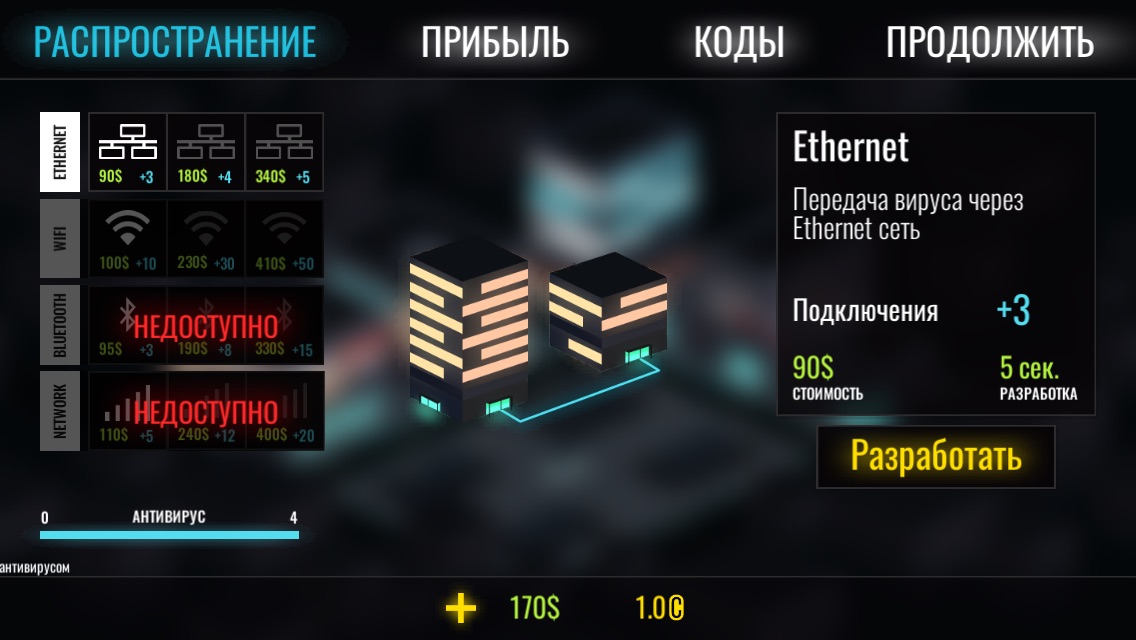
Need to say, we changed the principle of infection. After the first game, we realized that there was little interactivity in our game, and we need more player involvement in the infection. It was decided to make manual infection with the main one. Virus development has automated the infection process. For manual infection of the building, a mini-game was made, where you should collect all the green indicators with a slider.
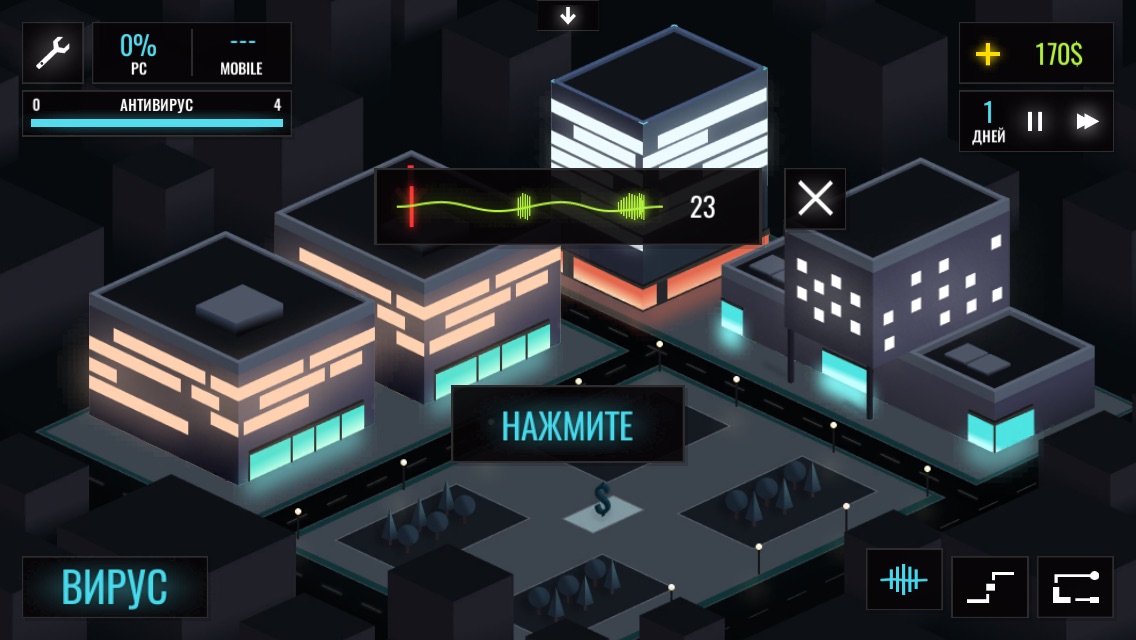
We also decided that a person with a virus will move on the map (it is yellow) and it transmits the virus to other people's mobile devices. To transmit a virus, you need to click on the blinking person.
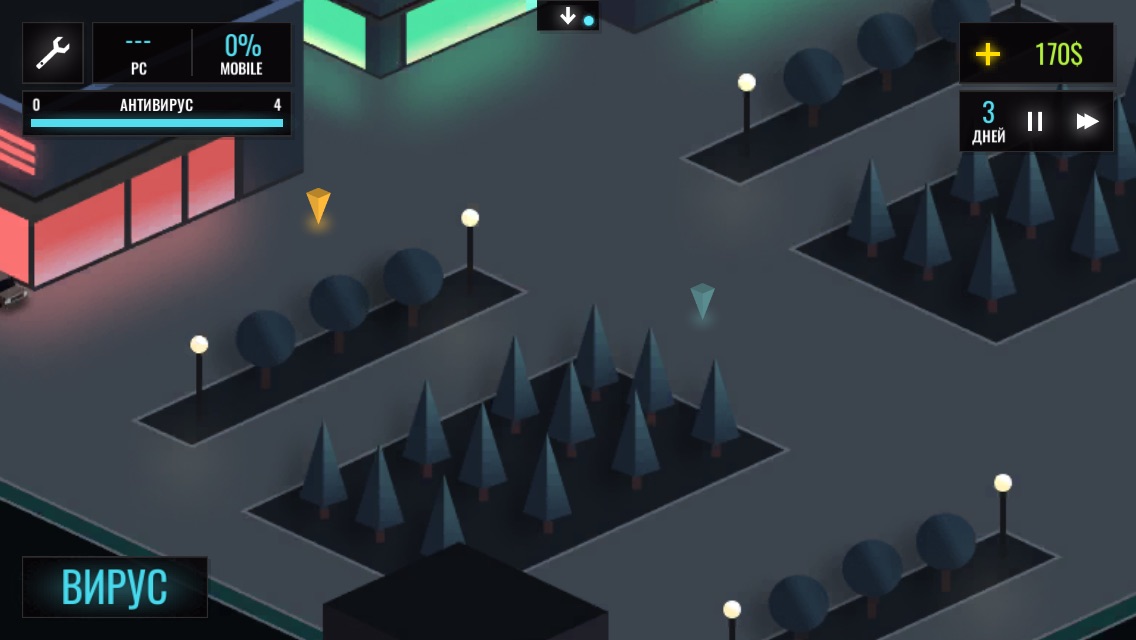
There was already a lot of interactivity and we really liked the original result. I also liked the more real simulation of infection. Development of wifi allowed to infect windows in the house, ethernet - to transmit the virus between houses. Bleeding bluetooth and mobile networks allows you to automate the infection of smartphones.
Changed the process of infection of the building. Each house had several windows. After winning a mini-game, one window is infected.
The big difference was in antivirus. In the first part, if the development of antivirus reaches 100%, then the loss occurs in a few seconds.
In the second part, we decided to make the antivirus a full-fledged character. That is, if the virus infects, then the antivirus neutralizes. The stronger the antivirus, the more devices it can disarm in one moment.
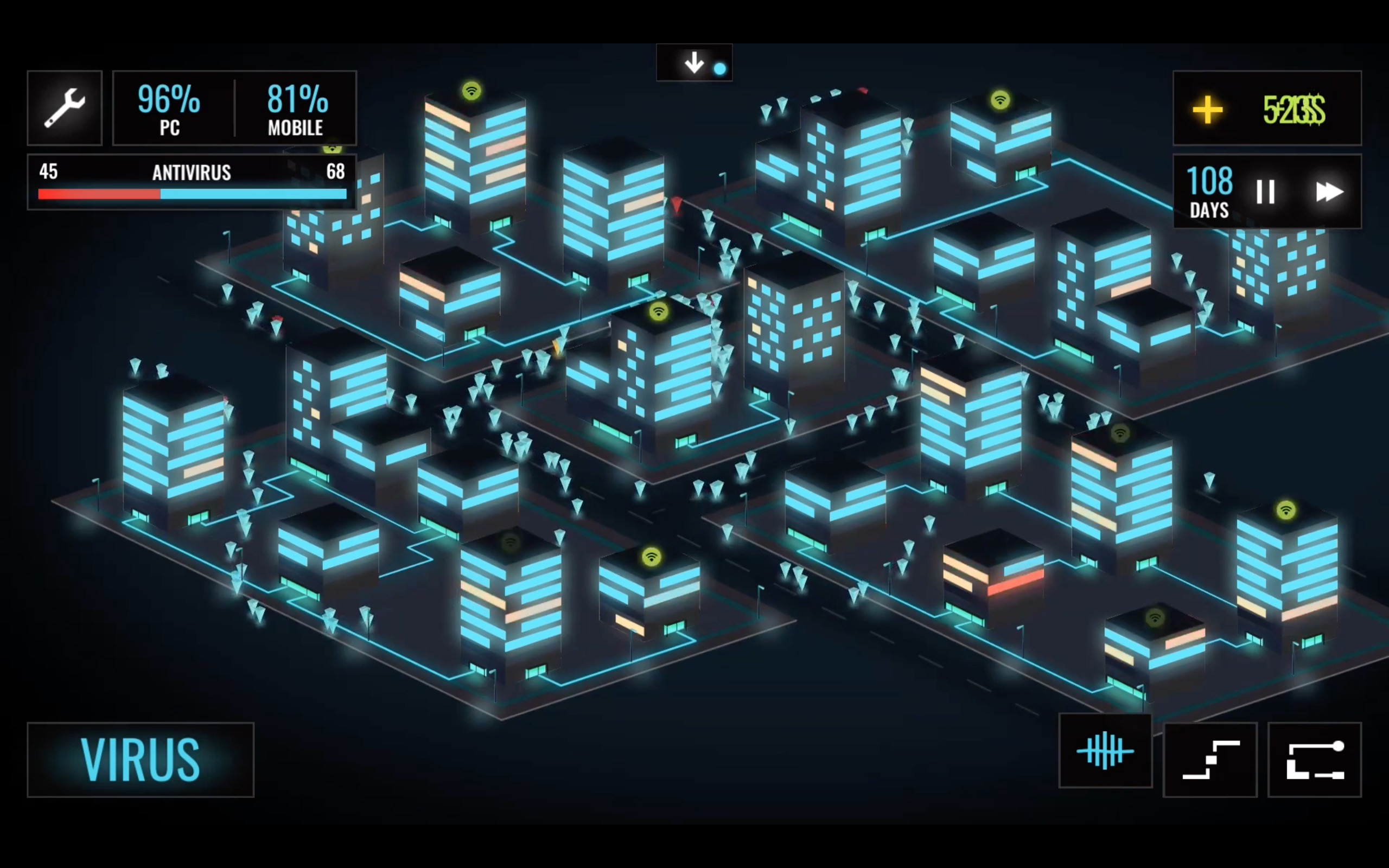
If the virus and antivirus are strong, then you can watch for their apparent opposition, helping the virus to infect devices. It looked cool.
By analogy with the previous game, we saved the chat and made also the competitive part, who will pass the level faster.
We decided that we will not limit ourselves to one level. After the scandal involving the hacking of elections in the United States, we thought it would be cool to hack elections in a game. The idea was this - there is a city in which elections will soon be held. The authorities are oligarchs and thieves in law, and honest people have no chance to change anything. But there is a hacker in this city, and its task is to help honest people take power in elections.
The election level should be the final of the campaign, so we came up with 8 different levels, where the player had to break into a bank, antivirus company, police, and a security building. The first two are learning levels.
Somewhere in mid-December, we had the first 4 levels ready. Based on them, we made a beta version for Android and iOS. We collected feedback and started working on the following levels.
In late January, all levels were completed.
Specific buildings at the levels (Bosses) were different, and for each of them the user needs to build his infection strategy.

Also in the game 2 currencies were used.
Dollar - at the level for the purchase of modifications.
Bitcoin (then changed to Coin) - a global currency that can be exchanged for dollars and open closed levels.
Recent improvements
In late January, the game was ready, but we obviously lacked something. And it seemed to be played well, but on the other hand, it was dry, there was not enough filling, liveliness. A week we were in thoughts and almost desperate, but the designer had an idea. Make different types of infection. That is, by analogy with the militants, these were different types of weapons. They should be different and have their pros and cons. So, we left the first password-breaking mini-game. In the case of a win, it infects one window in the house; in case of losing the mini-game, nothing happens.
The second type is a logical mini-game. You are given a logic diagram, you need to put a beam into the HACK, lighting the indicators. Something like a logical-electric puzzle.

In case of victory in the house, 3 windows are infected, in case of defeat, the antivirus is increased by 1.
Several such schemes have been made, with logical elements being randomly generated in each scheme. That is, the set of schemes was huge.
The third type was to control the ball, collecting all the green indicators. At the same time it is impossible to crash into the red walls, otherwise the ball stops for a while.
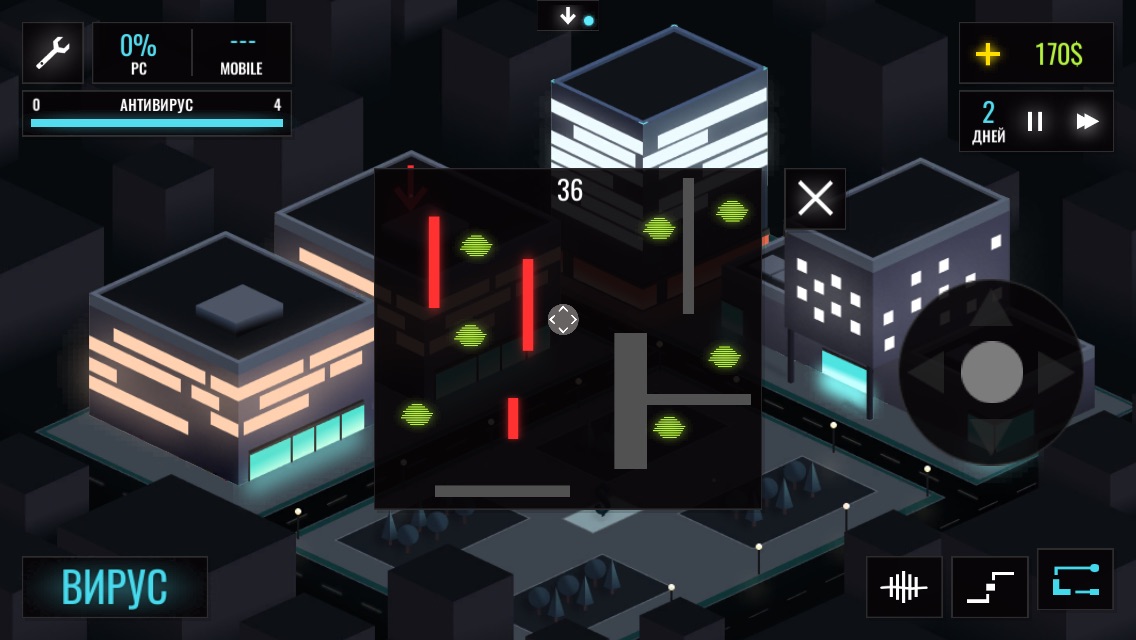
In case of victory in the house, 5 windows are infected, in case of defeat, the antivirus is amplified by 2.
Many such mini-games have been made.
This update was implemented with minimal losses in the finished game. After that, the game was really ready.
Now the player would have to choose which manual infection to use, what to pump in the virus development window. At each level, you need to find your successful infection strategy.
At the end of February, you released a game for Android and iOS.
Problem release at Apple and promotion of the second part
We decided that we would no longer invest so much in advertising.
In the first part of the current day, we earned no more than $ 170 (about $ 350 was spent).
It was decided to spend about 14,000 rubles on advertising for both platforms.
In Android, the game appeared almost immediately, but with Apple this time there were huge delays. At first they did not like the fact that we use bitcoin as a domestic currency. We fixed it on the coin. Then we waited for a review for 2 weeks, until I filed an appeal. And then 2 weeks we were reviewed.
During this time, we spent about 2000 rubles on advertising in the Play Market. The first few days a day were 100-200 installations (advertising slightly increased this number). And after that, something happened, and we started to recruit 1500-2000 units per day. Below 1,500 installations per day we did not fall.
It was very strange. We were not in the top games and did not invest money on advertising. I think we got recommendations for our audience thanks to the Play Market (there is a similar thing on YouTube). Therefore, the game began to download a large number of people, and we received a huge amount of feedback.
By adding improvements and fixing bugs, we updated the game for Android and waited for Apple's check. A month later, at the end of March, Apple finally released our game and we immediately posted a huge update so that the versions in the Play Market and the App Store were the same.
About 10,000 rubles we spent on native advertising VC, it lasted for several days. We again entered the TOP simulator for iOS, but left it as soon as the ads ended.
At the current moment on PlayMarket we have more than 70 thousand installations, under iOS about 3 thousand installations.

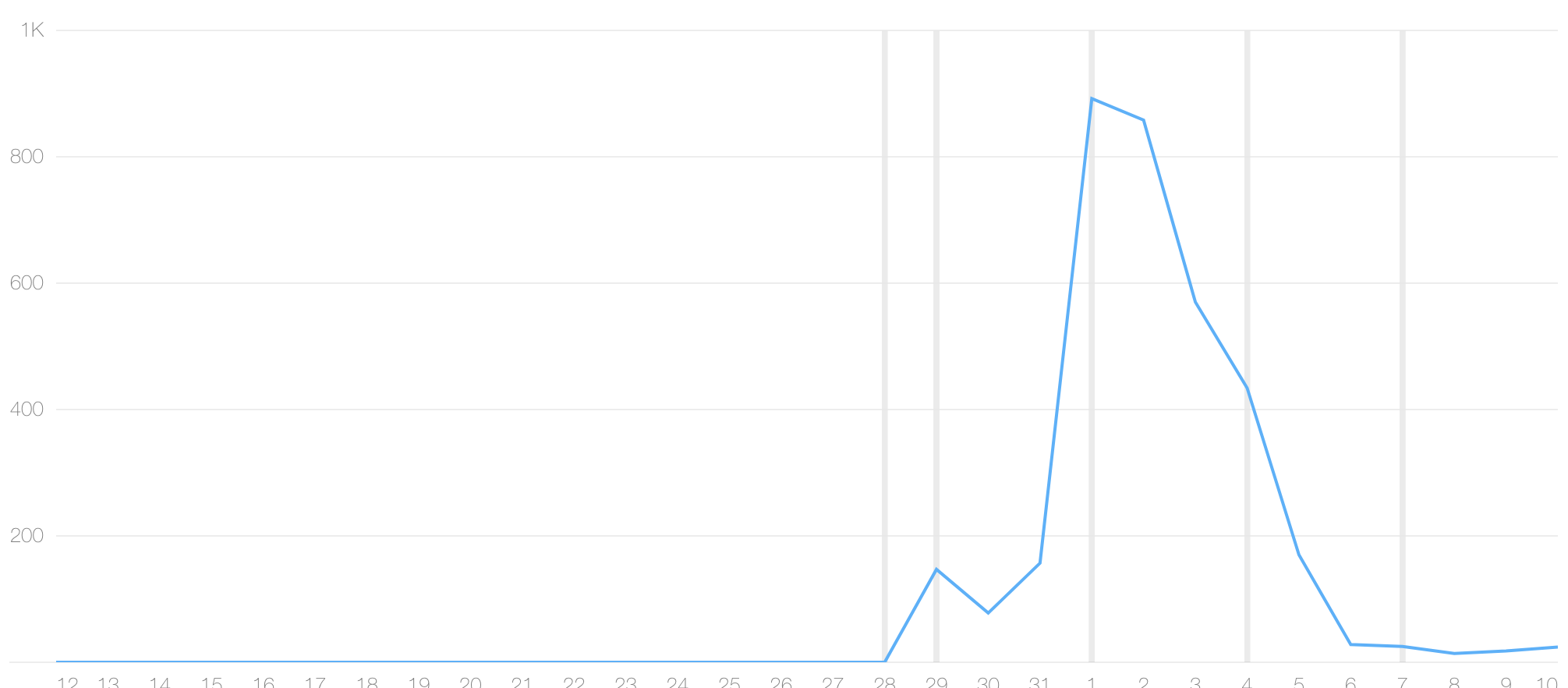
Now we are promoting the iOS version using free methods such as posts on Facebook, VK, reddit.
The Android version is very good at promoting itself.
During this time we added to the game:
- Survival rates
- Workshop. In it, you can improve the characteristics that affect mini-games, as well as buy various ball skins for the latter type of mini-games.

In the second game, we have earned about $ 420 at the moment, which I consider to be a good start.
My conclusions about the comparison of the Play Market and Apple:
- Apple is very easy to get into the TOP, just ordering installation or advertising. But as soon as the advertising is over, don’t be surprised at how quickly you leave.
- This was my first experience on the Play Market, but I can say Recommendations are a very cool thing. This applies to the Play Market and YouTube. For me, on the Play Market, if you get into Recommended - this is much cooler than getting into the TOP, because of those recommended by your game, people close to your target audience will put
And finally, farewell to all game developers:
- Do not delay the first release. That is, it is not necessary to constantly add and improve something. Set a plan for what should be released.
- Get stuck on intermediate results. Made a small component, it works and the game got better? Praise yourself. You can not always tell yourself that something is missing.
- If you work for enthusiasm, and not for money, do not build large-time projects. Many projects that are developed over a year or more than a year die at the development stage due to the lack of physical and emotional strength from the developer.
- If you have a small project, remember: “Release is close.” There are moments when you get tired, you start to enrage, annoy and do not want anything at all. Here you need not to break, but through the power to finish the project and press this magic button: “Publish”. After publication, this accumulated stress will disappear from you, and positive feedback and feedback will generally make you forget that you were with a week ago :)
Thanks for attention.
')
Source: https://habr.com/ru/post/353510/
All Articles